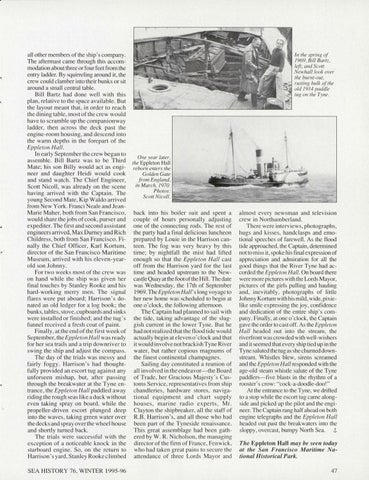all other members of the ship's company. The aftermast came through this accommodation about three or four feet from the entry ladder. By squirreling around it, the crew could clamber into their bunks or sit around a small central table. Bill Bartz had done well with this plan, relative to the space available. But the layout meant that, in order to reach the dining table, most of the crew would have to scramble up the companionway ladder, then across the deck past the engine-room housing, and descend into the warm depths in the forepart of the Eppleton Hall. In early September the crew began to assemble. Bill Bartz was to be Third Mate; his son Billy would act as engineer and daughter Heidi would cook and stand watch. The Chief Engineer, Scott Nicoll, was already on the scene having arrived with the Captain. The young Second Mate, Kip Waldo arrived from New York . Franci Neale and JeanMarie Maher, both from San Francisco, would share the jobs of cook , purser and expediter. The first and second assistant engineers arrived, Max Durney and Rich Childress, both from San Francisco. Finally the Chief Officer, Karl Kortum, director of the San Francisco Maritime Museum, arrived with his eleven-yearold son Johnny. For two weeks most of the crew was on hand while the ship was given her final touches by Stanley Rooke and his hard-working merry men. The signal flares were put aboard; Harrison ' s donated an old ledger for a log book; the bunks , tables, stove, cupboards and sinks were installed or finished; and the tug ' s funnel received a fresh coat of paint. Finally, at the end of the first week of September, the Epple ton Hall was ready for her sea trails and a trip downriver to swing the ship and adjust the compass. The day of the trials was messy and fairly foggy . Harrison's had thoughtfully provided an escort tug against any unforseen mishap, but, after passing through the breakwater at the Tyne entrance, the Eppleton Hall paddled away riding the rough seas like a duck without even taking spray on board, while the propeller-driven escort plunged deep into the waves, taking green water over the decks and spray over the wheel house and shortly turned back. The trials were successful with the exception of a noticeable knock in the starboard engine. So, on the return to Harrison's yard, Stanley Rooke climbed SEA HISTORY 76, WINTER 1995-96
In the spring of 1969, Bill Bartz, leji, and Scott Newhall look over ¡ the burnt-out, rusting hulk of the old 1914 paddle tug on the Tyne.
One year later, the Eppleton Hall reborn enters the Golden Gate from England, in March, 1970. Photos: Scott Nicoll.
back into his boiler suit and spent a couple of hours personally adjusting one of the connecting rods. The rest of the party had a final delicious luncheon prepared by Louie in the Harrison canteen. The fog was very heavy by this time; by nightfall the mist had lifted enough so that the Eppleton Hall cast off from the Harrison yard for the last time and headed upstream to the Newcastle Quay at the foot of the Hi 11. The date was Wednesday, the 17th of September 1969. The Eppleton Hall' s long voyage to her new home was scheduled to begin at one o'clock, the following afternoon. The Captain had planned to sail with the tide, taking advantage of the sluggish current in the lower Tyne. But he had not realized that the flood tide would actually begin at eleven o'clock and that it would involve not brackish Tyne River water, but rather copious magnums of the finest continental champagnes. Sailing day constituted a reunion of all involved in the endeavor-the Board of Trade, her Gracious Majesty's Customs Service, representatives from ship chandleries, hardware stores, navigational equipment and chart supply houses, marine radio experts, Mr. Clayton the shipbreaker, all the staff of R.B. Harrison's, and all those who had been part of the Tyneside renaissance. This great assemblage had been gathered by W.R. Nicholson , the managing director of the firm of France, Fenwick, who had taken great pains to secure the attendance of three Lords Mayor and
almost every newsman and television crew in Northumberland. There were interviews, photographs, hugs and kisses, handclasps and emotional speeches of farewell. As the flood tide approached, the Captain, determined not to miss it, spoke his final expression of appreciation and admiration for all the good things that the River Tyne had accorded the Eppleton Hall. On board there were more pictures with the Lords Mayor, pictures of the girls pulling and hauling and, inevitably, photographs of little Johnny Kortum with his mild, wide, pixielike smile expressing the joy, confidence and ¡dedication of the entire ship 's company. Finally, at one o'clock, the Captain gave the order to cast off. As the Eppleton Hall headed out into the stream, the riverfront was crowded with well-wishers and it seemed that every ship tied up in the Tyne saluted the tug as she churned downstream. Whistles blew, sirens screamed and the Eppleton Hall responded with the age-old steam whistle salute of the Tyne paddrers-five blasts in the rhythm of a rooster' s crow: "cock-a-doodle-doo!" At the entrance to the Tyne, we drifted to a stop while the escort tug came alongside and picked up the pilot and the engineer. The Captain rang half ahead on both engine telegraphs and the Eppleton Hall headed out past the breakwaters into the sloppy, overcast, bumpy North Sea. ;t,
The Eppleton Hall may be seen today at the San Francisco Maritime National Historical Park.
47
